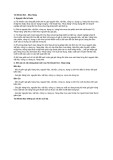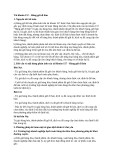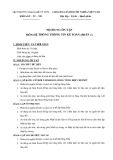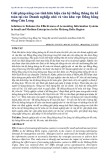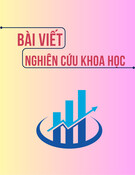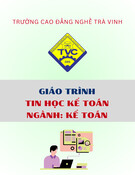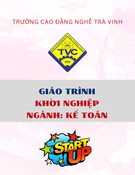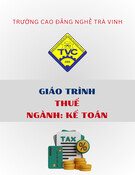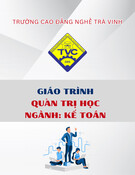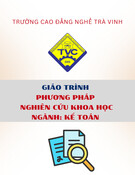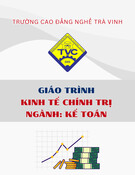
FTU Working Paper Series, Vol. 2 No. 1 (09/2021) | 82
PHÂN TÍCH HỆ THỐNG KẾ TOÁN ĐỐI VỚI HOẠT ĐỘNG BÁN LẺ CỦA
CÔNG TY TNHH IVY MANAGEMENT SOLUTIONS
Nguyễn Đức Dũng1
Sinh viên K56 CTTT Quản trị kinh doanh – Khoa Quản trị kinh doanh
Trường Đại học Ngoại thương, Hà Nội, Việt Nam
Nguyễn Thúy Anh
Giảng viên Khoa Quản trị Kinh doanh
Trường Đại học Ngoại thương, Hà Nội, Việt Nam
Tóm tắt
Các công ty vừa và nhỏ, đặc biệt trong lĩnh vực bán lẻ, luôn gặp khó khăn trong việc thiết lập một
hệ thống kế toán hiệu quả và có năng suất cao. Tuy nhiên, các nghiên cứu trong lĩnh vực kế toán
phần lớn tập trung vào môi trường tài chính vĩ mô cho các mô hình kinh doanh quy mô lớn. Bởi
vậy, bài nghiên cứu này nhắm tới việc xác định các vấn đề cốt lõi trong thiết kế và triển khai hệ
thống kế toán phù hợp cho doanh nghiệp vừa và nhỏ, thông qua nghiên cứu điển hình công ty
TNHH Ivy Management Solutions. Bài nghiên cứu sử dụng phương pháp phân tích định tính và
nghiên cứu điển hình. Nghiên cứu đã xây dựng một mô hình phân tích toàn diện dựa trên các lý
thuyết kế toán và các phương pháp thực hành tốt nhất trong kế toán doanh nghiệp để đánh giá thực
tiễn hệ thống kế toán của công ty TNHH Ivy Management Solutions. Dựa trên cơ sở này, nghiên
cứu đưa ra các khuyến nghị liên quan đến việc tìm kiếm nhân sự cấp cao cho phòng Tài chính và
cải thiện các chức năng của hệ thống quản lý thông tin (MIS) hiện tại. Mô hình phân tích toàn diện
nói trên cũng sẽ hữu ích cho các doanh nghiệp vừa và nhỏ khác trong việc đánh giá vả cải thiện hệ
thống kế toán của mình.
Từ khoá: hệ thống kế toán, hoạt động bán lẻ, doanh nghiệp vừa và nhỏ, mô hình phân tích.
AN ANALYSIS OF ACCOUNTING SYSTEM IN RETAIL OPERATION OF
IVY MANAGEMENT SOLUTIONS LTD.
Abstract
Having an efficient and effective accounting system has always been a struggle to SMEs, especially
retail business. However, studies in the subject of accounting system have been largely focused on
the macro financial environment for large-scale business model. This research paper aims to
identify the core problems in designing and implementing a suitable accounting system for SMEs,
by studying the case of Ivy Management Solutions Ltd, specifically its retail operation. The
qualitative and case study methods are applied in the paper. A holistic model was built by authors
1 Tác giả liên hệ, Email: dung.nguyenduc99@gmail.com
Working Paper 2021.2.1.07
- Vol 2, No 1

FTU Working Paper Series, Vol. 2 No. 1 (09/2021) | 83
based on the accounting theories and best practices in business and accounting application to assess
the performance of Ivy Management Solutions Ltd. On this basis, it is recommended that Ivy
Management Solutions Ltd. hire a new talent to lead the Finance Department and improve the
functions of its Management Information System. The holistic model can be also applicable for
other SMEs.
Keywords: accounting system, retail operation, SME, analysis model.
1. Introduction
The effectiveness of accounting system is very crucial for the business operation, especially
in retail operation. There was plenty of research done about these issues. However, there are
questions that are left unanswered.
Firstly, there is a lack of official study about financial matters for SMEs. Most studies on this
topic are general and unfocused, funded by governments and corporations. On one hand, this is
good for the economy and the creation of many modern finance instruments and the global
financing market itself, lay the stone for the invention of e-currency such as Bitcoin and Ethereum;
but, on the other hand, this leaves out SMEs. Studies about financial management in SMEs are
hardly founded because they have been struggling to survive in a competitive market and have no
resource to produce proper research about how they manage their finance information.
Furthermore, financial information is kept secret from competitors, so a wide and comparable
research among SMEs is an impossible task. In short, most financial studies, besides being general,
are only benefiting the macro economy as a whole and large corporations, not individual problems.
Secondly, the financial market and instrument is always growing and evolving. Fraud risks
can occur at any step of the financial management process, and the methodology for fraud is ever
changing. Moreover, the risk in retail operation is even higher, in which the accounting system
process involved employees from multiple levels. These are the reasons for continuous
development for fraud detection and prevention. A plan or method to mitigate fraud risk for SMEs
is needed.
Lastly, business needs a fully functional accounting system to provide the business with
cutting edge knowledge to increase the competitiveness of operation. Retail businesses with its
fast-changing pace of business will benefit greatly on a functional accounting system. Therefore,
a complete study for accounting system and its functions is needed.
In conclusion, previous studies are general and failed to recommend practical solutions for
SMEs to increase the effectiveness of accounting system, and also failed to provide a
comprehensive model to assess accounting system in SMEs. The author of this research paper will
try to fill this gap, by studying the operation and accounting system of Ivy Management Solution
Ltd. during the period of 2018 – 2019. By looking into the financial records and accounting system
of IMS, this paper will provide a completed model to assess the standard accounting system for
SMEs and recommend a practical solution to improve IMS ’s accounting performance, which can
be applicable for others.
2. Literature review
2.1. Accounting system

FTU Working Paper Series, Vol. 2 No. 1 (09/2021) | 84
An accounting system is consisted of accounting and system. Accounting is a method of
recording, analyzing and summarizing transactions data of a business (BPP Learning Media,
2019), while system is understanded as a way of doing things, or a set of connected things and
devices that operate together (Cambridge University Press, 2021). Together, an accounting system
can be understood as a set of connected devices or procedures that record, analyze and summarize
transactions data of a business.
Accounting is considered as one of the significant and most critical factors for both Private
and Public entities. With many financial methodology and applications, decision making process
can improve its effectiveness due to the collection of supporting data. Moreover, accounting is
viewed as an economic management tool which supports in summarizing, controlling and
recording of financial transactions of the companies (Allen, et al., 2012). The main objective of
the accounting system is to provide specific information to the various stakeholders which includes
investors, public, creditors and the government authorities. The aim behind providing the
information is that with the help of this information, related parties can effectively analyze the
financial condition, development, growth and profitability of the companies.
According to the research of Burns and Needles (1994), the theory of accounting was first
conceptualized in early 1930s. With more than 80 years in development, it has been assessed that
with the advancement and development of accounting, a standard modern financial system must
be able to carry out the followings: collect and record transactions information, process
transactions data, issue financial and management reports (BPP Learning Media, 2019).
Specifically, for SME retail business, the accounting system is also in charge of executing
transactions (Horngren et al., 2013).
Collecting and recording transactions information is always important for a business.
Nowadays, every decision is expected to be data-driven, therefore, this function is the most crucial
for an accounting system, as accounting is the method of recording, analyzing and summarizing
transactions data (BPP Learning Media, 2019). For example, a business can know its profit for the
month, and calculate the amount needed to invest in inventory next week based on the transaction
information in the last month.
Processing transactions data is usually computerized, using Management Information System.
This provides the company with advantages of processing large amount of data in less time,
improving accuracy, increasing functionality and issuing better external reports (Ghasemi et al.,
2011). With the support of Information Technology, a sale manager can get real time update on
his or her department’s performance without going through papers and invoices, which makes the
decision-making process simpler and easier than before.
Issuing financial and management reports can provides important information that helps
coordinate decentralized decision-making in different departments of the company. In the modern
era, decision making process is data driven. Therefore, the competitiveness level of the accounting
system in regard of the ability to provide crucial information in a timely manner is extremely
important for business operation. The information needs of managers are mainly covered by
reports based on information from the management accounting and financial accounting. The
reports are drawn up according to the manager’s objectives, which relate to managerial functions
(Munteanu et al., 2011).

FTU Working Paper Series, Vol. 2 No. 1 (09/2021) | 85
Executing transactions refers to the method for settling payment are designed to manage with
the expense and the risks related with the procedure. Costs emerge through processing fees,
transfer taxes, and the maintenance of collateral, while risk arises because one party may not keep
its end of the contract. For instance, the purchaser will most likely be unable to financing, or the
seller can’t deliver the products. The process of executing a transaction can be loosely divided into
three categories of execution, clearing and settlement, according to the opinion of Santomero,
Viotti & Vredin (2013). The execution stage requires the most attention from the stakeholders
involved, and with the development of banking system and technology nowadays, business
concern is mostly about the process of execution, and how to avoid fraud and dysfunction during
this step.
According to Foundations in Accountancy: Accountant in Business (2019), the Finance
Department, who is responsible for the operation of the accounting system, should carry out the
followings:
• Financial Accountant and Management Accountant provides information and reports to
relevant stakeholders. However, their needs are different, and not all stakeholders are equally
satisfied. The information analyzed was the transaction data from executing transactions activities,
processed by a Management Information System.
• Treasurer is responsible for executing transactions, which in the process collecting
transaction data for Financial Accounting and Management Accounting to process
• Processing and recording are often computerized, using a Management Information System.
In conclusion, the purpose of the accounting system is to execute transactions, collect and
record transaction data, process data and provide financial statements and management reports.
2.2. Elements of an accounting system
One of the important elements of an accounting system is people, who is heavily involved in
the operation of the business as well as the accounting procedures. Typically, the Finance
Department of a company usually has the following structure:
Figure 1. Typical structure of a Finance Department
Source: (BPP Learning Media, 2019)
In which, each of the separated subdivision has its own responsibility (BPP Learning Media,
2019):

FTU Working Paper Series, Vol. 2 No. 1 (09/2021) | 86
• Treasurer is responsible for fund raising, investing surplus and controlling cashflow. To
fulfill their objectives, Treasurer manages the Input Stages of the accounting system. The
transaction data was later processed and stored by their Management Information System.
• Financial Controller is responsible for routine accounting, providing accounting reports and
cash controlling. Financial Controller use information provided by the Management Information
System.
• Management Accountant is an important part of the business, as they have a vital and
separate responsibility to do cost accounting, budget control and financial management for
projects. Management Accountant also use information provided by the Management Information
System.
Usually in a SME, the Accounting Department is responsible for the above. In smaller
company (05-10 people), the department consists only one to two people to act simultaneously as
a Financial Controller, Management Accountant and Treasurer. SMEs usually have General
Accountant positions, which responsible for all procedures below.
A standard accounting system must be able to do financial accounting procedure and
management accounting procedure (Tan Thanh Thinh Ltd., 2021), which issues financial
statements and management reports for relevant stakeholders. Financial accounting procedure is
required and heavily regulated by the government, as it is the method to determine tax balance of
a company, based on its income and expense. Financial accounting standards are expressed in
Circulars and Decree from the Government, and the information required is fixed. Financial
statements are often referred to as external statements, as it illustrates the status quo of the company
and does not include crucial information for the prediction growth of the company. For example,
standard financial statements from a retail business are not required to disclose the growth rate of
its customer base, which is very important for this business model. The Vietnamese government
also has requirements for receipts, invoices and payments (Vietnamese Congress, 2019), therefore,
in SMEs, financial accounting function has to execute transactions, including payment and receipt
as well to uphold the standards. This procedure is done by Financial Controller.
To fulfill the need for management – related information, the shareholders established another
system to produce internal reports, or management reports. Management accounting procedure
collects the data that are relevant to the operation and management of the business and generates
meaningful information from this. Moreover, to suit the management needs, these reports are
customizable. For example, the managers of a retail business can require a tracking number of
their growing customer base on monthly basis. These reports are issued by Management
Accountant.
To generate the mentioned reports and statements, the accounting system requires processed
data. Therefore, another crucial part of the accounting system is the procedures to collect and
process transactions data (BPP Learning Media, 2019).
There are two procedures to collect transactions data: purchase procedure and sale procedure.
The purchase procedure collects information about payments the company made and execute the
settlements, while the sale procedure collects the receivables from external stakeholders. The
Vietnamese government issued requirements for the process of collecting transactions data, as well
as provide proof of payment or receipt (Vietnamese Congress, 2019).





